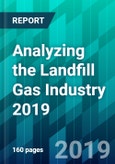Due to the strict regulations being put in place worldwide related to greenhouse emissions, the global landfill gas industry is set to grow at a steady pace in the years to come. Increasing demand for renewable and clean energy sources is further boosting the industry growth and outlook until 2023. For example, in 2016, the Singaporean government declared new targets towards reducing the country's carbon emissions by over 35% by 2030. As smart landfills come up, the global landfill gas industry is poised to benefit from trends such as an increased effort towards recycling waste and the ever-growing demand for energy worldwide.
With the increasingly global focus of energy conservation and stress on clean generation, Landfill Gas has emerged as a source which is an available backdoor, is proven to be economical in cost perspective and is a growing energy resource in the modern world. The mounting advent of megacities with their generation of megatons of waste materials coupled with their growing energy consumption needs has forced civilization to take a deeper look at understanding energy recycling in every form.
According to the US Environmental Protection Agency's (EPA) Landfill Methane Outreach Program (LMOP), there are still over 600 landfills that are viable candidates for project development, with a potential gas flow capacity of over 280 bcf per year.
Looking at landfill gas (LFG) in technical terms, it is a byproduct of the decay process carried out on LFG at municipal solid waste (MSW) landfills. The gas generated from such landfills is an approximate composition of 50% methane and 50% carbon dioxide, coupled with some additional trace compounds. The source heat value of LFG ranges from 400 to 600 British Thermal Units (Btu)/cubic foot and can be adapted to burn in any number of applications by carrying out minor adjustments to fuel/air ratios. The applied usage of LFG provides comprehensive economic and environmental benefits and the users of LFG have achieved significant cost savings compared as compared to their earlier use of traditional fuels. This has mainly been due to the fact that LFG costs are composed of consistently lower costs than the cost of natural gas.
Analyzing the Landfill Gas Industry 2019 pertains to the basics of understanding the composition, natural production, and transportation of Landfill Gas in the normal economic model. The report analyzes the limitations to the production of LFG and the best periods to capitalize on the generation of the gas. Certain hazards posed by this gas which warrant safe usage practices along with the procedures to assess the potential biohazard any landfill site presents before LFG can be harvested from it.
Any energy analysis is not complete without understanding the environmental impact of that energy source and the technologies deployed for the effective treatment of this energy resource in order to make it safe, clean and usable. The report also analyzes the control measures used in order to utilize LFG as an effective energy tool after the recovery and storage of LFG leading to energy generation. The report also analyzes certain case studies of such implementation of LFG processes.
Table of Contents
A. Executive Summary
Companies Mentioned
- BMW








